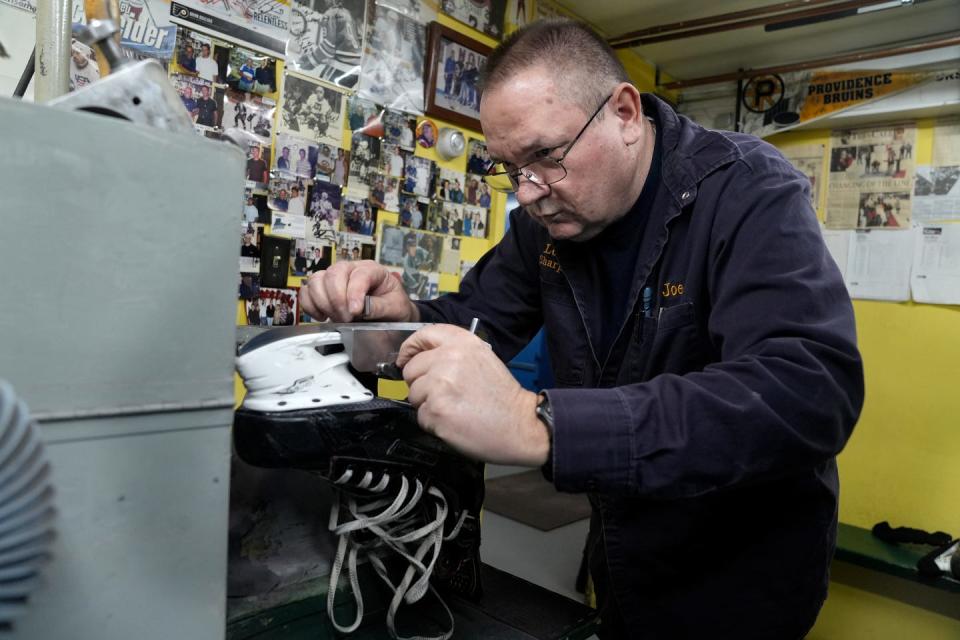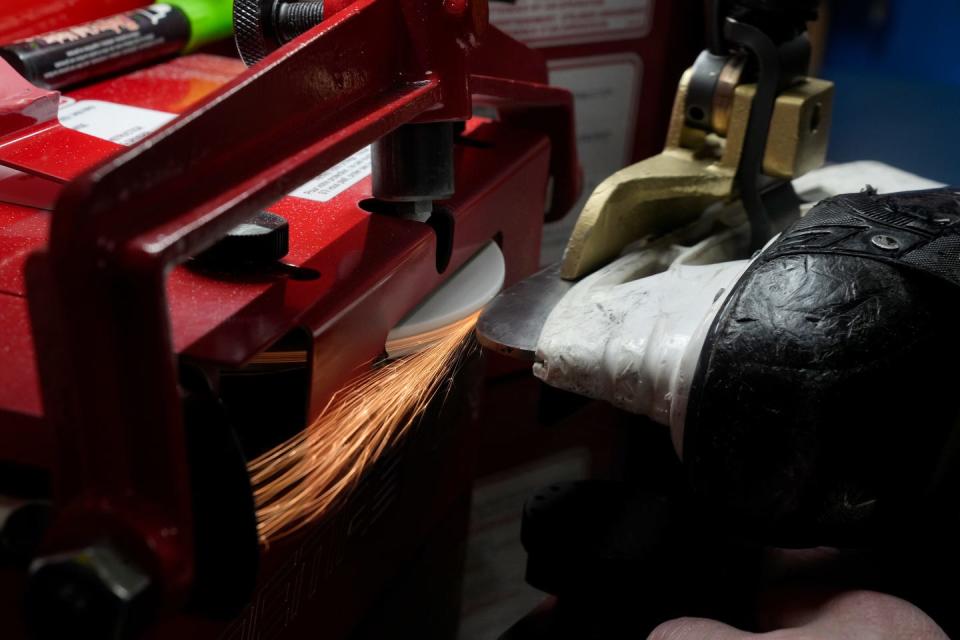Art of the blade: Meet RI's legendary ice skate sharpeners
WOONSOCKET – Twenty minutes before game time, in a crowded ice rink locker room, the Mount St. Charles Academy hockey player discovered one of his skate blades badly dulled.
He reached for his cellphone: “Are you down there, Mr. Lemay?”
Two streets below Adelard Arena, inside a small white Cape house with an "OPEN” flag swaying from the porch, Joe Lemay assured the worried skater he was there and standing by.
In no time, a teenager carrying the player’s skates dashed down the stairs to Lemay’s basement and into a small side room unchanged for decades: walls plastered with autographed photographs of appreciative former Mount players who had made it to the NHL. And in the center stood two heavy, custom-built skate sharpening machines dating back to the 1970s.
Skate sharpeners have earned their place in RI's rich hockey history
Hockey is an evolving game with faster, more-skilled players than ever before. But be they high schoolers, pros or men’s-league amateurs who play year-round, most practice a devotion to one person behind the scenes they entrust to give them the edge they need.
Over the years, some sharpeners have earned renown in Rhode Island’s rich hockey history for their attention to each skater’s preferences; there are different ways to sharpen a blade, after all.
Some skaters like a deep “hollow,” the concave arch that runs the length of each blade. It’s a sharper edge that digs deeper into the ice, but it can give, say, an older skater with bad knees the sensation of slogging in snowshoes. Others prefer a shallower “hollow” that allows for more flow with less exertion.

Back in the 1970s, when Bruins’ mania spurred hockey interest across New England, Roger Guillemette, a machinist, was the man to know. He is said to have designed and built the sharpening machine used by the St. Louis Blues. And as he worked out of the new Smithfield Rink back then, he offered more than just a hollowed edge.
He promoted “rocking” the blade, meaning grinding off more steel on the ends so there is less contact with the ice and more maneuverability for the skater. And he could pitch a skater slightly forward by taking off more steel at the front of the blade than the back.
Roland “Rollie” Woodcock was a legend in the Providence/East Providence area for decades, until his death in 2013.
He sharpened skates at the Rhode Island Auditorium in Providence in the 1970s, home of the minor league Rhode Island Reds, then for decades honed skates for Providence College and Brown University hockey teams – and scores of beer-league faithful.
Rollie’s became such a popular place for bantering skaters to linger that history tells how Rollie took some of the chairs out of his shop so he could get his work done.
What about self-sharpeners?
Now, in this automated world, technology offers self-sharpeners. One company called Sparx advertises that a skater can simply drop their skates into its $700 machine and go off and grab a cup of coffee while it grinds the blades to perfection.
Some traditional sharpeners say that’s the equivalent of settling for a paint-by-numbers portrait of your mother when you could have had it painted by Monet.

“Maybe it’s OK if you’re really paying attention to what’s happening,” says Lemay, 59, trying to be polite. “I don’t want to say anything bad, but we’re old school here.”
'The Edge Doctor'
Eight miles away in Smithfield, Derek Signoriello, who opened his own shop three years ago, is less diplomatic about automated sharpeners.
"They advertise that any dad can just go over and stick the skate in and it’s going to come out great,” says Signoriello, who advertises as "The Edge Doctor.” "No! Wrong! It’s going to come out like crap. The kid’s not going to know how to skate.”
As he talks, Signoriello, 46, passes a skate, positioned on its side, back and forth along the stainless-steel counter of his new Blade Master machine. The motion resembles a pianist sliding up and down the keys.
With each pass, a stationary grinding wheel hones a new blade for 18-year-old Jack Fiske, who sits waiting on the shop couch.
Fiske, a senior on Lincoln High School’s hockey team, says he’s been coming to Signoriello since he was 7, when Signoriello was working at Manny’s Sports in Cumberland.
“I’ve been to other places, but they haven’t been as good,” Fiske says. “He’s the best.”
Signoriello says he has customers from Putnam, Connecticut to Taunton, Massachusetts, and even some out-of-state college students who mail their blades home for their parents to drop them off in the blade box he keeps outside. (Most hockey skates today have quick release systems where blades can pop off and on, allowing skaters to change blades like a pit crew changes tires.)
“The secret to good sharpening is consistency; everything has to feel similar,” Signoriello says. “The blade is an extension of your foot, and any subtle change magnifies the difference and affects performance.”
Most regular skaters get their skates sharpened after every few hours on the ice. The going rate: $10.
Scott Cline, an assistant coach of the Lincoln hockey team, comes into Signoriello’s shop with his son.
“Most of our guys come here,” Cline says. “My son comes here. If I take his skates somewhere else, he can tell. He’s like, ‘Derek didn’t sharpen my skates, I don’t like them.'"
Everyone has their favorite sharpener
Back at Lemay’s, Jason Archambault of Johnston pulls up with his son, Nico, who plays for Mount and needs a sharpening. He runs in with his skates.
“I'm 47 and he’s 14 and I've been coming here since I was younger than him,” his father says.
“Automated machines have sort of changed the game for the average skater, but this gentleman here has a precision, an eye, like his dad (Robert) who always did my skates. It’s a different level of expertise.”
Plus, says Archambault, “I love the nostalgia. I remember coming here at night as a kid and you’re in the basement surrounded by all those pictures. It means a lot to me, those little things.”
The other day, when that other Mount kid went racing into Lemay’s basement with his friend’s skates just before game time, Lemay noticed one skate was also missing a rivet.
He popped in a new one, sharpened both blades and hurried the teen out of the shop.
No charge, he said. Just get back up to the rink before the puck drops.
Contact Tom Mooney at: tmooney@providencejournal.com
This article originally appeared on The Providence Journal: Skate sharpeners in RI preserve the art of manually sharpening blades

